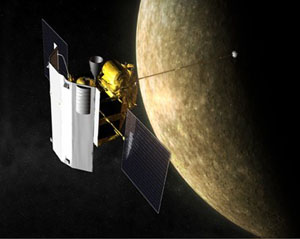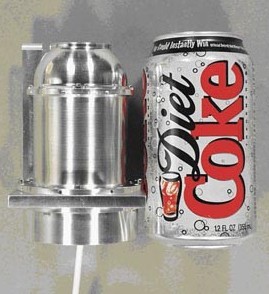You might expect that astronomers would know all there is to know about the composition of our nearby planetary neighbours, but apparently not. By measuring the charged particles in the planet Mercury’s magnetic field, a sensor has allowed scientists to make the first observations about the surface and atmospheric composition of the world closest to the Sun.
In a paper published in Science on American Independence Day, 4th July, Thomas Zurbuchen, of the Departments of Atmospheric, Oceanic and Space Sciences and Aerospace Engineering at the University of Michigan explains how the data give us several new insights into this sprightly planet: Holy cow, we found way more than we expected! Zurbuchen enthuses, We now know more about what Mercury’s made of than ever before.

Artist’s impression of MESSENGER in orbit around Mercury (Credit: NASA/Johns Hopkins University Applied Physics Laboratory/Carnegie Institution of Washington)
Zurbuchen is project leader of the Fast Imaging Plasma Spectrometer (FIPS), a small sensor, about the size of a cola can on board the MESSENGER spacecraft, which performed the first of three scheduled Mercury flybys in January 2008.
It was more than three decades ago, with the Mariner 10 mission to Mercury in 1975 that scientists discovered the planet’s magnetic field. They have speculated ever since as to how this magnetic field and the solar wind interact with the planet’s surface and exosphere, or thin atmosphere.

Size comparison of FIPS sensor and cola can (Credit: MichiganAerospace.com)
The FIPS sensor detected silicon, sodium, sulfur and even water ions around Mercury, which the scientists suspect are being blasted from the surface of the planet or its exosphere by the solar wind. It’s like we did a forensic analysis of Mercury, Zurbuchen explains, This flyby got the first-ever look at surface composition.

Thomas Zerbuchen (Credit: University of Michigan)
Zurbuchen points out that Mercury’s magnetosphere is full of many different ionic species, both atomic and molecular, and with a variety of electrical charges. What is in some sense a Mercury plasma nebula is far richer in complexity and makeup than the Io plasma torus in the Jupiter system, he says.
Io is a volcanically active moon of the gas giant planet Jupiter and is usually considered to be one of the most exciting space environments. This latest data from MESSENGER suggest that Mercury’s surface composition may be just as interesting. It may also have been determined to some degree by volcanic activity on the planet.
Further reading
Science, 2008, 321, 90
http://dx.doi.org/10.1126/science.1159040
Messenger homepage
http://messenger.jhuapl.edu/index.php
Thomas Zurbuchen
http://www.ns.umich.edu/htdocs/public/experts/ExpDisplay.php?ExpID=1252
Mercury’s magnetosphere fends off the solar wind
http://www.ns.umich.edu/htdocs/releases/story.php?id=6301
Suggested searches
Mercury
magnetism